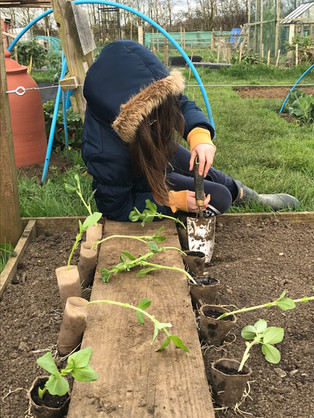Grow your own - Dig for Victory - Broad Beans
- Mar 20, 2020
- 4 min read

Ok so we said yesterday that we'd talk next about how and where we might grow our veg. And we will. Tomorrow. But today we've got to adapt as we have to look after Edie. She's in her last year before she goes to "big school" and was due to take her SATS over the next few months.....
Instead she's at home with her dad. And what better education than to learn about how plants grow? A lesson for life..................
Our first experience of broad beans was some 45 years ago when we added one to a bottle and watched it grow. So that's where we'll start with Edie. Here she's added a few beans to a bottle that she's filled with damp kitchen roll. Over the coming days we'll watch them as they develop and eventually grow out of the top of the bottle. They'll soon be calling out for Jack!
This shows us all we need to know about seeds, what they need to germinate and to grow - water, warmth, sunlight and a "medium" to grow in. We'll be able to see how the seed develops a root structure and reaches shoots upwards to get light. Easy! What better lesson than that?
Last year we planted up two double rows of 2m each and enjoyed 3.5 kgs of beans.
This year we're going for more - if space allows. These are what we have to go in so far. Ok so they're a bit leggy so we've planted them deeper in the soil. And then we'll sow some more. And here are the leggy ones in the ground.
And here's Edie planting up some more in fibre pots. We like using those as we can pop them straight into the ground and the roots that have already developed and are poking through the sides will simply continue into the soil as the pot itself simply rots down.
Some people say it's a good idea to plant the seeds on their side so the water that we add doesn't stay on the seeds for too long as it might rot them. You can see that's how we plant ours although their is a view that beans are intelligent seeds and are able to cope and to right themselves so that they grow in the way that nature intended.
Might not be completely true though and might explain why a few seem to have rotted and didn't germinate as well as their brothers and sisters! These were confined to the compost bin.
Those that Edie has sown will be lightly watered and then go into the heated propagator to get them off to a flying start. You don't need a heated propagator. Sowing seeds in trays or pots that you can then cover with a clear lid or pop in a clear bag and leave in a warm, sunny place - your kitchen windowsill - can work just as well.
We could have sown them directly into their final growing space but we like to keep an eye on them in the early days once they've germinated. We'll need to gradually introduce them to the great outdoors - harden them off - but that works for us - even if it does mean slightly more work.......
We've sown them in the Autumn in the past but the only ones to benefit from that have been the mice!
As you might know we're lucky in that we have an allotment - the diggings as we fondly refer to it as. That means we have quite a lot of space that we can use for our beans. This year though in addition to the diggings we're going to grow some in pots and see how they manage and what sort of yields we get off a plant grown in that way.
We'll write more articles as the beans develop. Watch this space...........
For now some Broad Bean facts:
They're easy to grow - all they need is decent soil, good light and water.
If your soil drains well and if it stays reasonably warm over the winter - and if you plant the right variety in the Autumn - you can harvest beans towards the end of the following Spring.
You eat the seed - either raw or cooked, fresh or dried. Apart from soft fruit and some carrots - hang on - another idea for an article - there's nothing more satisfying than shelling a broad bean and eating it......
They've been around for years - even Stone Age settlers and Romans ate them. If they were good enough then we reckon they're good enough now!
They store extremely well - they can either be blanched and frozen - as we do - or they can be dried.
They're good for you - they're rich in riboflavin and vitamin C - which can help maintain our energy supply and help protect our body's cells, skin, blood vessels and bones.
So there you have it. Easy to grow, with some history (!) and good for you! Why wouldn't you want to give them a go?
Watch this space for updates on how ours thrive and what we do with them at each of the vital stages - and what you need to do with yours.
Happy sowing!
Alistair.
If you'd like to get in touch you can contact us through our facebook page, at hello@thetrugandlettuce.co.uk or on 07734 365028


























Comments